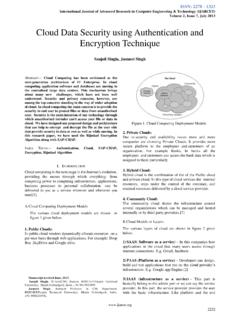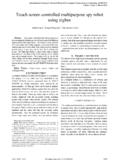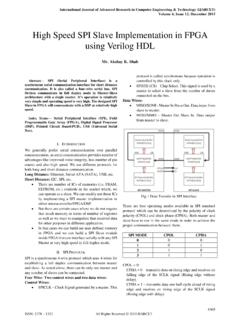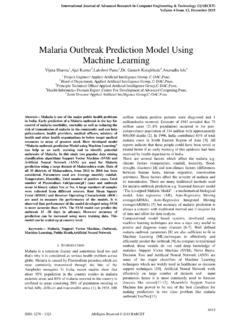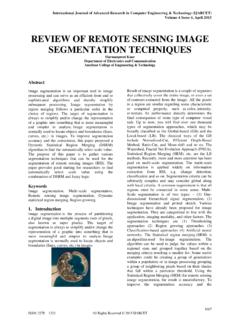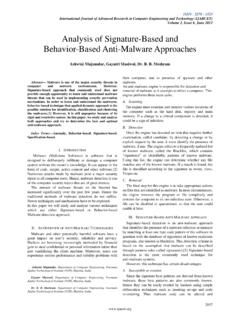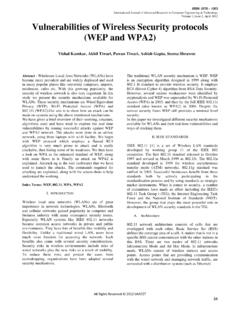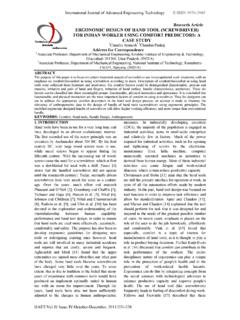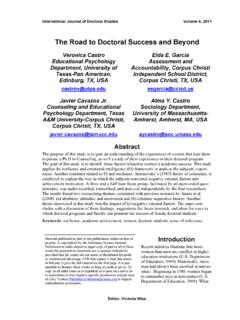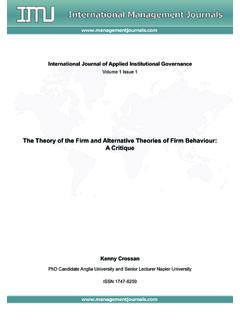Transcription of ISSN: International Journal of Advanced Research …
1 issn : 2278 1323 International Journal of Advanced Research in Computer Engineering & Technology (IJARCET) Volume 2, Issue 2, February 2013 568 All Rights Reserved 2013 IJARCET 5G Mobile Technology Ms. Reshma S. Sapakal #1, Ms. Sonali S. Kadam #2 #Computer Science and Engineering Department, Shivaji University Arvind Gavali College of Engineering, Panmalewadi,Varye, Satara, Maharashtra, India Abstract 5G Technology stands for fifth Generation Mobile technology. From generation 1G to and from 3G to 5G this world of telecommunication has seen a number of improvements along with improved performance with every passing day. This fast revolution in mobile computing changes our day to day life that is way we work, interact, learn etc. This paper also focuses on all preceding generations of mobile communication along with fifth generation technology. Fifth generation network provide affordable broadband wireless connectivity (very high speed).
2 The paper throws light on network architecture of fifth generation technology. Currently 5G term is not officially used. In fifth generation researches are being made on development of World Wide Wireless Web (WWWW), Dynamic Adhoc Wireless Networks (DAWN) and Real Wireless World. Fifth generation focus on (Voice Over IP) VOIP-enabled devices that user will experience a high level of call volume and data transmission. Fifth generation technology will fulfill all the requirements of customers who always want Advanced features in cellular phones. The main features in 5G mobile network is that user can simultaneously connect to the multiple wireless technologies and can switch between them. This forthcoming mobile technology will support IPv6 and flat IP. Fifth generation technology will offer the services like Documentation, supporting electronic transactions (e-Payments, e-transactions) etc.
3 Keywords 5 G, 5G Architecture, Evolution from 1G to 5G, Comparison of all Generations, Why 5G? . I. INTRODUCTION Wireless communication has started in early 1970s. In next four decades, a mobile wireless technology has evolved from 1G to 5G generations. Fifth generation technology offer very high bandwidth that user never experienced before. The Fifth generation technologies offer various new Advanced features which makes it most powerful and in huge demand in the future. Now days different wireless and mobile technologies are present such as third generation mobile networks (UMTS- Universal Mobile Telecommunication System, cdma2000), LTE (Long Term Evolution), WiFi (IEEE wireless networks), WiMAX (IEEE wireless and mobile networks), as well as sensor networks, or personal area networks ( Bluetooth, ZigBee). Mobile terminals include variety of interfaces like GSM which are based on circuit switching.
4 All wireless and mobile networks implements all-IP principle, that means all data and signaling will be transferred via IP (Internet Protocol) on network layer. Fifth generation technology provide facilities like camera, MP3 recording, video player, large phone memory, audio player etc. that user never imagine and for children rocking fun with Bluetooth technology and Piconets. The fifth generation wireless mobile multimedia internet networks can be completely wireless communication without limitation, which makes perfect wireless real world World Wide Wireless Web (WWWW). Fifth generation is based on 4G technologies. The 5th wireless mobile internet networks are real wireless world which shall be supported by LAS-CDMA(Large Area Synchronized Code-Division Multiple Access),OFDM(Orthogonal frequency-division multiplexing), MCCDMA(Multi-Carrier Code Division Multiple Access), UWB(Ultra-wideband), Network-LMDS( Local Multipoint Distribution Service), and IPv6.
5 Fifth generation technologies offers tremendous data capabilities and unrestricted call volumes and infinite data broadcast together within latest mobile operating system. Fifth generation should make an important difference and add more services and benefits to the world over 4G. Fifth generation should be more intelligent technology that interconnects the entire world without limits. This generation is expected to be released around 2020. The world of universal, uninterrupted access to information, entertainment and communication will open new dimension to our lives and change our life style significantly. II. EVOLUTION Mobile communication has become more popular in last few years due to fast revolution in mobile technology. This revolution is due to very high increase in telecoms customers. This revolution is from 1G- the first generation, 2G- the second generation, 3G- the third generation, and then the 4G- the forth generation,5G-the fifth second generation.
6 A. First Generation(1G) 1G emerged in 1980s. It contains Analog System and popularly known as cell phones. It introduces mobile technologies such as Mobile Telephone System (MTS), Advanced Mobile Telephone System (AMTS), Improved Mobile Telephone Service (IMTS), and Push to Talk (PTT). It uses analog radio signal which have frequency 150 MHz, voice call modulation is done using a technique called Frequency-Division Multiple Access (FDMA).It has low capacity, unreliable handoff, poor voice links, and no security issn : 2278 1323 International Journal of Advanced Research in Computer Engineering & Technology (IJARCET) Volume 2, Issue 2, February 2013 569 All Rights Reserved 2013 IJARCET at all since voice calls were played back in radio towers, making these calls susceptible to unwanted eavesdropping by third parties [3]. B. Second Generation(2G) 2G emerged in late 1980s.
7 It uses digital signals for voice transmission and has speed of 64 kbps. It provides facility of SMS(Short Message Service) and use the bandwidth of 30 to 200 KHz. Next to 2G, system uses packet switched and circuit switched domain and provide data rate up to 144 kbps. GPRS, CDMA and EDGE [3] C. Third Generation(3G) It uses Wide Brand Wireless Network with which clarity is increased. The data are sent through the technology called Packet Switching. Voice calls are interpreted through Circuit Switching. Along with verbal communication it includes data services, access to television/video, new services like Global Roaming. It operates at a range of 2100 MHz and has a bandwidth of 15-20 MHz used for High-speed internet service, video uses Wide Band Voice Channel that is by this the world has been contracted to a little village because a person can contact with other person located in any part of the world and can even send messages too[3].
8 D. Fourth Generation(4G) 4G offers a downloading speed of provides same feature as 3G and additional services like Multi-Media Newspapers, to watch programs with more clarity and send Data much faster than previous generations [3]. LTE (Long Term Evolution) is considered as 4G technology. 4G is being developed to accommodate the QoS and rate requirements set by forthcoming applications like wireless broadband access, Multimedia Messaging Service (MMS), video chat, mobile TV, HDTV content, Digital Video Broadcasting (DVB), minimal services like voice and data, and other services that utilize bandwidth. [2] III. COMPARISON OF ALL GENERATIONS OF MOBILE TECHNOLOGIES [5]. Technology Features 1G 2G 3G 4G 5G Start/ Deployment 1970 1980 1990 - 2004 2004-2010 Now Soon (probably 2020) Data Bandwidth 2kbps 64kbps 2 Mbps 1 Gbps Higher than 1 Gbps Technology Analog Cellular Technology Digital Cellular Technology CDMA 2000 (1xRTT, EVDO) UMTS, EDGE WiMax LTE Wi-Fi WWWW(coming soon) Service Mobile Telephony (Voice) Digital voice, SMS, Higher capacity packetized data Integrated high quality audio, video and data Dynamic Information access, Wearable devices Dynamic Information access, Wearable devices with AI Capabilities Multiplexing FDMA TDMA, CDMA CDMA CDMA CDMA Switching Circuit Circuit, Packet Packet All Packet All Packet Core Network PSTN PSTN Packet N/W Internet Internet TABLE 1 COMPARISON OF ALL GENERATIONS OF MOBILE TECHNOLOGIES IV.
9 5G NETWORK ARCHITECTURE Fifth generation mobile systems model is all-IP based model for wireless and mobile networks interoperability. The All-IP Network (AIPN) is capable to fulfill increasing demands of the cellular communications market. It is a common platform for all radio access technologies. The issn : 2278 1323 International Journal of Advanced Research in Computer Engineering & Technology (IJARCET) Volume 2, Issue 2, February 2013 570 All Rights Reserved 2013 IJARCET AIPN uses packet switching and its continuous evolution provides optimized performance and cost. In fifth generation Network Architecture consist of a user terminal (which has a crucial role in the new architecture) and a number of independent, autonomous radio access technologies (RAT) [1]. In 5G Network Architecture all IP based mobile applications and services such as Mobile portals, Mobile commerce, Mobile health care, Mobile government, Mobile banking and others, are offered via Cloud Computing Resources (CCR).
10 Cloud computing is a model for convenient on-demand network access to configurable computing resources ( , networks, servers, storage, applications, and services). Cloud computing allows consumers to use applications without installation and access their personal data at any computer with internet access. CCR links the Reconfigurable Multi Technology Core (RMTC) with remote reconfiguration data from RRD attached to Reconfiguration Data models (RDM). The main challenge for a RMTC is to deal with increasing different radio access technologies. The core is a convergence of the nanotechnology, cloud computing and radio, and based on All IP Platform. Core changes its communication functions depending on status of the network and/or user demands. RMTC is connected to different radio access technologies ranging from 2G/GERAN to 3G/UTRAN and 4G/EUTRAN in addition to WLAN and WMAN.
